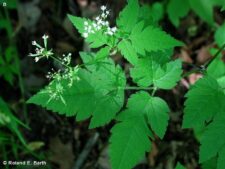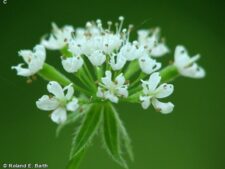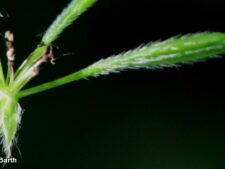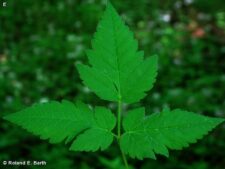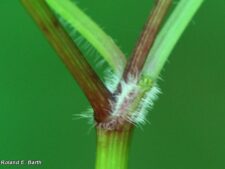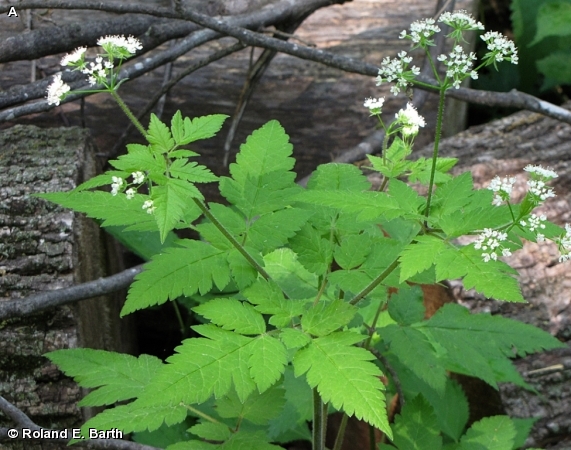
SWEET CICELY
Osmorhiza claytonii
PARSLEY FAMILY (Apiaceae)
 Identification
Identification
- Flowering time - May, early June
- Common in moist woodlands - floodplain, ravines, uplands
- Clusters of tiny white flowers rising above the leaves
- Leaves divided into 3 toothed leaflets
- Shorter styles than closely related Anise Root (Osmorrhiza longistylis) - see comments for details
This native perennial grows to 3 feet tall with smooth or hairy stems and leaves divided several times resulting in 3 triangular-shaped, toothed leaflets (A,B,E). The small white flowers are arranged in clusters (compound umbels) on top of stalks higher than the leaves (A,B). A closer look reveals each flower cluster is composed of about 5 smaller groups (umbellets) of several small individual flowers (C). The fruit is an elongated capsule which continues to show the 2 styles at its end (D). The length of these styles – less than 1/16 inch long on the fruit – separates Sweet Cicely from Anise Root (Osmorhiza longistylis) which as the name implies, has longer styles up to 1/8″ long on the fruit. Separating these 2 species is not an easy task. See comments for details.
This plant flowers and quickly sets fruit in May and early June. It is common in moist woodlands of Fontenelle Forest and Neale Woods, especially in the ravines.
The field mark most often used to separate Sweet Cicely (Osmorrhiza claytoni) from closely related Anise Root (Osmorrhiza longistylis) is its shorter styles (1/16 vs 1/8 inch), not an easy task. It is said that Sweet Cicely lacks the anise scent given off by the roots or crushed foliage of Anise Root and some other sources indicate Sweet Cicely has fewer tiny flowers (less than 7) in each umbellet. Probably best to simply enjoy your encounter with this really beautiful spring wildflower, call it Anise Root or Sweet Cicely or whatever, and have a nice springtime walk in the woods.
The content of NatureSearch is provided by dedicated volunteer Naturalists of Fontenelle Forest who strive to provide the most accurate information available. Contributors of the images retain their copyrights. The point of contact for this page is: Roland Barth.

